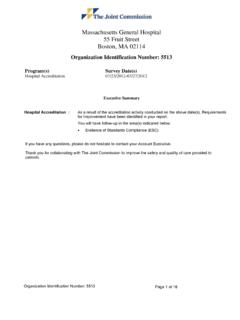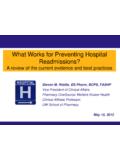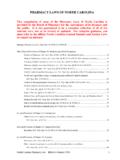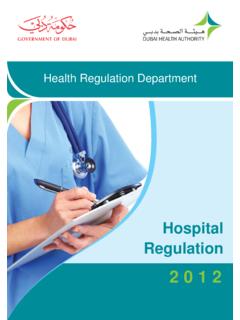Transcription of chapter 45 Hospital pharmacy management
1 chapter 45 Hospital pharmacy managementSummary Responsibilities of Hospital staff and stock management Medication Organization of Hospital pharmacy services Physical Hospital drug and therapeutics committee and functions Membership Hospital formulary management Drug use Inpatient medication management distribution systems Bulk ward stock Individual medication order system Unit-dose medicine distribution Automated medication dispensing Patient medication profiles Medication treatment record Ward and department inspections Dangerous drugs and controlled substances After-hours Small-scale Hospital pharmaceutical production and course-of-therapy packaging Nonsterile production Sterile Pharmaceutical disposal Controlling leakage and drug abuse and further readings guide 45-1 Multiple-department pharmacy system 45-2 Sample ward inspection record 45-3 pharmacy production and control work sheet 45-1 Comparison matrix for pharmaceutical distribution system 45-2 Pharmaceutical repackaging studiesCS 45-1 Functions of a Hospital drug and therapeutics committee in Afghanistan 45-2 Procedure for use of nonformulary medicines in a Hospital 45-3 Kenya medication treatment record 45-4 Scaling up methadone maintenance therapy in Vietnam 45-5 Assessing the feasibility of small-scale pharmaceutical production in the Catholic Diocesan Hospital Pharmacies of Ghana I: Policy and economic issuesPart II: Pharmaceutical managementPart III.
2 management support systemsPlanning and administrationOrganization and management43 Security management44 Medical stores management45 Hospital pharmacy management46 Pharmaceutical management for health facilities47 Laboratory services and medical suppliesInformation managementHuman resources managementcopyright management sciences for health ORGAnIzATIOn AnD MAnAGeMenTAppropriate medicine use in the Hospital setting is a multi disciplinary responsibility that includes Selection and formulary management by a multi-disciplinary committee Prescribing by the physician Procurement, storage, medication order review, and preparation and dispensing by the pharmacy depart-ment Medication administration by nurses or other health care professionals Monitoring the effect of medicines on the patient by all members of the health care teamThe drug and therapeutics committee (DTC) is respon-sible for developing policies and procedures to promote rational medicine use. Its functions include management of the approved medicine list or hospi-tal formulary Ongoing drug use review Adverse drug event reporting and implementation of safe medication practicesMembers of the DTC should include representatives from the medical, pharmacy , and nursing staffs; Hospital administrators; and the quality assurance coordinator.
3 Subcommittees are often formed for in-depth analysis of particular pharmacy department, under the direction of a qualified pharmacist, is responsible for the procurement, storage, and distribution of medications throughout the Hospital . In larger hospitals, satellite pharmacies may bring the pharmacist closer to patient care areas, facili-tating interactions between pharmacists and patients. In some settings the pharmacist is used as a resource for medicine information and specialized medication therapy may be distributed in bulk, in courses of therapy, or in unit doses. Unit-dose distribution is opti-mal for patient care but requires initial capital outlay for repackaging equipment and medication cabinets. Recent technological advances, such as computerized dispensing machines and bar coding, are now available to further promote safe medication practices. Additional mechanisms for inpatient medicine manage-ment include Patient medication profiles, maintained in the phar-macy department Medication administration records, maintained by nurses Periodic inspection of medicine storage areas Procedures for strict control of dangerous drugs and controlled substances Responsible disposal of pharmaceutical waste Procedures for after-hours pharmacy serviceSmall-scale pharmaceutical production often is not cost-effective and should be evaluated by the control of narcotics is of particular concern in the Hospital setting and requires a systematic approach for the prevention and detection of Hospital exists to provide diagnostic and curative ser-vices to patients.
4 Pharmaceuticals are an integral part of patient care. Appropriate use of medicines in the Hospital is a multidisciplinary responsibility shared by physicians, nurses, pharmacists, administrators, support personnel, and patients. A medical committee, sometimes called the drug and therapeutics committee, pharmacy and therapeutics committee, or the medicine and therapeu-tics committee, is responsible for approving policies and procedures and monitoring practices to promote safe and effective medicine use. The pharmacy department, under the direction of a qualified pharmacist, should be respon-sible for controlling the distribution of medicines and promoting their safe use. This task is challenging because medicines are prescribed by physicians, administered by nurses, and stored throughout the chapter covers Hospital -specific pharmaceutical management issues, such as pharmacy department orga-nization and alternative pharmaceutical distribution sys-tems. Several functions of the DTC are discussed, with an emphasis on formulary management .
5 Other important issues relevant to Hospital pharmaceutical management are treated in chapter 17 on treatment guidelines and formulary manuals, and Chapters 28 and 29 on investi-gating medicine use and on promoting rational pre-scribing, respectively. chapter 35, Pharmacovigilance, discusses adverse drug reaction monitoring and medica-tion error 45 / Hospital pharmacy management Responsibilities of Hospital staffThe Hospital pharmacist should be an expert on medicines who advises on prescribing, administering, and monitoring, as well as a supply manager who ensures that medicines are available through procurement, storage, distribution, inven-tory control, and quality assurance. The balance between these two roles varies, depending on the individual s back-ground and the work setting. A pharmacist may assume a prominent clinical role in settings where his or her knowl-edge of clinical pharmacology and capacity to provide expert advice have earned the acceptance of Hospital medi-cal and nursing responsibility for establishing policies and procedures related to medication selection, procurement, distribution, and use often lies with the DTC.
6 Because the medicine use process is multidisciplinary, the committee should include representation from all functional areas involved: medical staff, nursing, pharmacy , quality assurance, and Hospital and stock managementIn some hospitals, a separate department manages all hos-pital purchasing (pharmaceuticals, medical supplies, equip-ment, and so forth); this department may be called medical stores or materiel management . In such cases, the chief pharmacist prepares an annual budget request for pharma-ceutical purchases and places orders for medicines through the medical other settings, the pharmacy department manages pharmaceutical purchasing directly. no single individual should have total control of pharmaceutical procurement. A designated committee should review and approve all pur-chases; either a special purchasing committee or the DTC (see below) may manage this for procurement and inventory management should be written in a manual that has been approved by Hospital administration and the appropriate committees; the procedures for purchasing should follow guidelines provided in Chapters 18 and 23.
7 Stock management pro-cedures are determined by the facility s size and whether a warehouse is attached to the Hospital (see Chapters 44 and 46).Medication useThe medication-use process can be divided into four com-ponents 1. Prescribing. The physician has overall responsibility for the care of the patient, prescribing or ordering medications as part of the treatment plan. The mecha-nisms to ensure appropriate prescribing within the Hospital customarily fall within the purview of the medical staff committees, usually including the DTC. The DTC may establish protocols or procedures that allow pharmacists or nurses to prescribe within spe-cific Preparation and dispensing. The pharmacy depart-ment, under the direction of a registered pharmacist, is responsible for preparing and dispensing medications. Policies and procedures for these functions should be approved by the DTC. The chief pharmacist reports to Hospital Medication administration. Administering medica-tions is generally the responsibility of the nursing staff.
8 The chief nursing officer oversees all nursing functions. In some cases, physicians may administer medicines such as anesthetic agents. Other health care professionals may administer medicines within the scope of their practice (for example, midwives attending deliveries).4. Monitoring the effect of medications on the patient and ordering appropriate changes in therapy. Monitoring activities are primarily the responsibility of the physi-cian. However, observation and reporting are required from the person who administered the medication (usually the nurse) and from other members of the health care team involved in the patient s therapy. In some settings, a clinical pharmacist or pharmacolo-gist monitors medication therapy in the Hospital and consults on medication therapies that require special expertise to ensure safety and efficacy; for example, total parenteral nutrition, anticoagulation, or treat-ment with aminoglycoside agencies and licensing boards regulate medi-cations through laws and professional practice standards.
9 The laws and regulations usually specify that the chief phar-macist be the person responsible for the control of medica-tions within a Hospital , including procurement, storage, and distribution throughout the the chief pharmacist is responsible for the phar-maceutical budget and the control of medications, he or she does not supervise those who prescribe or administer the medications. In addition, in some hospitals, purchasing, receiving, and storing of medications are handled by a medi-cal stores department that is not under the supervision of the varying responsibilities illustrate the complex-ity of pharmaceutical procurement, storage, and use in the Hospital . efforts to improve the system should respect this complexity and include multidisciplinary representation and involvement. Coordination is required at the policy level through the DTC, at the management level (beginning with Hospital administration), and through the different branches of the organizational ORGAnIzATIOn AnD Organization of Hospital pharmacy servicesIn organizing Hospital pharmacy services, both the way in which the staff is organized and the physical layout of the building must be pharmacy personnel can be divided into three major categories 1.
10 management . management includes the chief pharma-cist and sometimes deputy chief pharmacists, who are responsible for procurement, distribution, and control of all pharmaceuticals used within the institution and for management of personnel within the pharmacy Professional staff. These professionals are qualified pharmacists who procure, distribute, and control medi cations and supervise support staff for these activities. In some facilities, pharmacists provide clini-cal consulting services and medicine Support staff. The support staff category often includes a combination of trained pharmacy technicians, cleri-cal personnel, and smallest hospitals may have only two or three phar-macy staff members, with the chief pharmacist as the only pharmacist. Larger teaching hospitals that provide extensive pharmaceutical distribution and clinical services may have more than 100 staff cornerstone for a well-functioning medication sys-tem is an up-to-date manual of policies and procedures.














